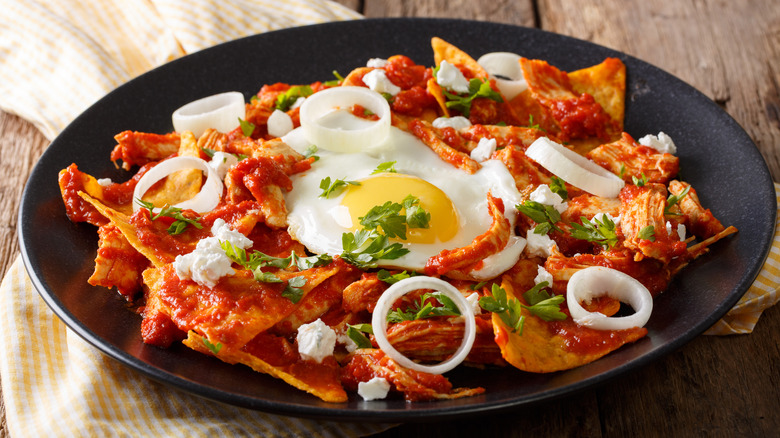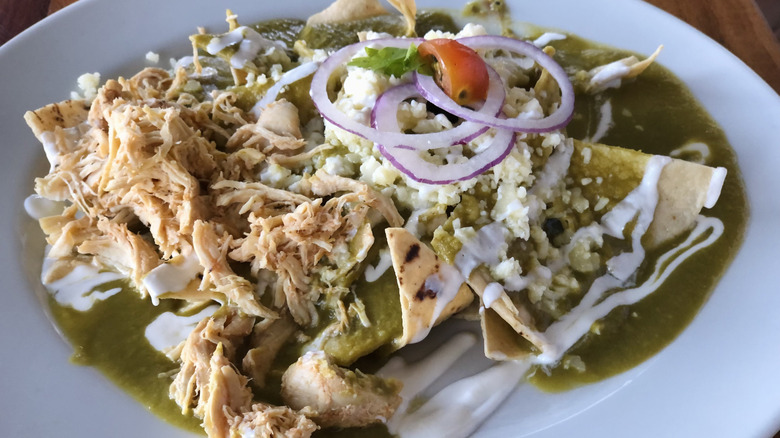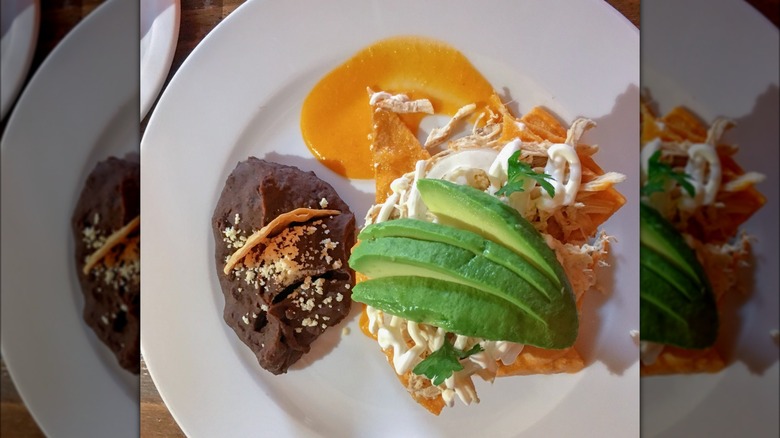How Chilaquiles Became A Breakfast Staple In Mexico
In Mexico, chilaquiles are considered a culinary and cultural staple. The combination of fried corn tortillas softened in fresh red or green salsa is simple, fresh, and absolutely delicious. The dish can be enjoyed any time of day but is particularly popular for breakfast, when it's sometimes topped with fried eggs and various toppings. The elements of tortillas and salsa make the dish unequivocally identifiable with Mexican cuisine, but to figure out how it became associated with the country in the first place, look to the Aztec civilization.
Corn was a staple ingredient in the Aztec culture. Using a process called nixtamalization, the ancient people would soak dried corn to help soften it and then process it to make things like tortillas. The name "chilaquiles" is derived from the Nahuatl language (which the Aztecs spoke), from the word "chīlaquilli" or "chīlāquilitl" which roughly translates to "something covered in chili." The Nahuatl word was documented in 1571 by a Spanish priest, but the Spanish word "chilaquiles" was first written in an 1821 recipe book to describe a dish of fried tortillas, clemole (a chili-tomato sauce), pork, and sesame seeds. In 1831, three types of chilaquiles are referenced in a book titled, "El Cocinero Mexicano." While it's certainly plausible that the Aztec people enjoyed a similar dish (two of their primary resources were corn and chiles, after all), there is no historical record of this fact. Certainly, the additions of things like cheese and onions came later with the arrival of Spanish conquistadores.
Carb-loading, Mexican-style
The concept of minimizing waste (even when the ingredient is stale) could be the reason why the dish is particularly popular during breakfast and brunch; any leftover tortillas from the day before can be fried up and soaked in salsa the next morning. And when you add an egg on top of anything, doesn't that immediately make a dish breakfast-appropriate?
With its ample amount of carbs from the stale tortillas (which also make excellent soup), protein from meat or eggs, and extra calories coming from the range of toppings that are excellent on Mexican chilaquiles (avocado, cheese, and sour cream or Mexican crema are popular), this dish gives plenty of sustenance to anyone who eats it, making it a popular choice for breakfast.
Nutrition aside, chilaquiles also happen to taste absolutely delicious. You get a good dose of spice depending on how hot the salsa is, plus the fried tortillas can be a mix of soft, chewy, and crunchy all at once. You can top them with meats like pork, chicken, and beef and flavor them with garnishes like cheeses, cilantro, onions, sliced radish, jalapenos, and hot sauce.
Don't just save it for breakfast
Some agree that chilaquiles makes a great dish to soften the effects of a hangover, a reputation shared by other Mexican specialties, menudo and pozole. While chilaquiles are overwhelmingly considered a breakfast dish, they can definitely be enjoyed for any meal, any time of day. Renowned author, chef, and restauranteur, Rick Bayless is a highly respected expert on Mexican cuisine and notes that there are different versions of chilaquiles all over Mexico. He also suggests that, in the country, the dish is commonly eaten after the first meal of the day, more towards afternoon. His recipe calls for either a green or red sauce to accompany the tortillas, with simple garnishes of crema, queso añejo, and slices of raw white onion.
Topping chilaquiles with eggs makes them an ideal breakfast food, but topping them with shredded chicken or beef could make them more appropriate for lunch or dinner. They become an excellent side dish when you don't top them with a protein at all. Chilaquiles can be made with red or green chile sauce (you can sometimes order them with both sauces); the tortillas or chips can be soaked in the sauce to become very soft, or they can be drizzled with the salsa, instead, so that they remain crispy. Many also like them somewhere in the middle, texture-wise.


